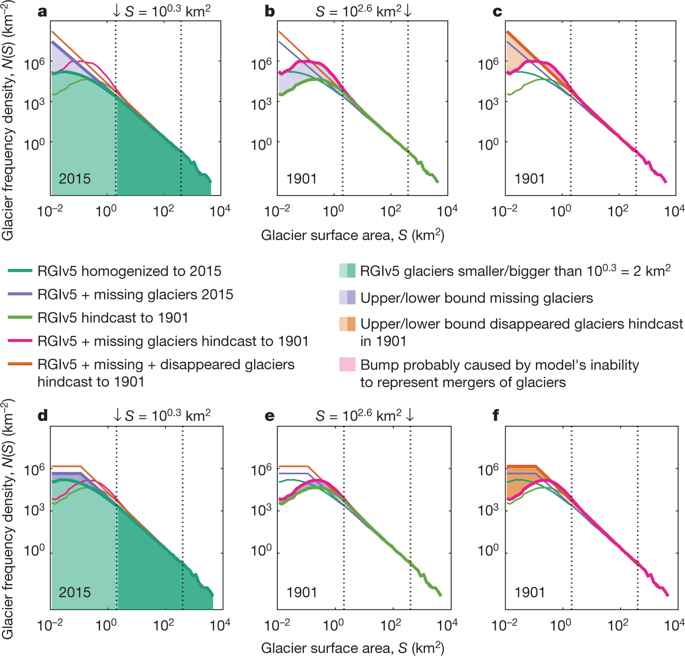Our official English website, www.x-mol.net, welcomes your feedback! (Note: you will need to create a separate account there.)
Twentieth-century contribution to sea-level rise from uncharted glaciers
Nature ( IF 64.8 ) Pub Date : 2018-11-01 , DOI: 10.1038/s41586-018-0687-9 David Parkes , Ben Marzeion
Nature ( IF 64.8 ) Pub Date : 2018-11-01 , DOI: 10.1038/s41586-018-0687-9 David Parkes , Ben Marzeion

|
Global-mean sea-level rise (GMSLR) during the twentieth century was primarily caused by glacier and ice-sheet mass loss, thermal expansion of ocean water and changes in terrestrial water storage1. Whether based on observations2 or results of climate models3,4, however, the sum of estimates of each of these contributions tends to fall short of the observed GMSLR. Current estimates of the glacier contribution to GMSLR rely on the analysis of glacier inventory data, which are known to undersample the smallest glacier size classes5,6. Here we show that from 1901 to 2015, missing and disappeared glaciers produced a sea-level equivalent (SLE) of approximately 16.7 to 48.0 millimetres. Missing glaciers are those small glaciers that we expect to exist today, owing to regional analyses and theoretical scaling relationships, but that are not represented in the inventories. These glaciers contributed approximately 12.3 to 42.7 millimetres to the historical SLE. Additionally, disappeared glaciers (those that existed in 1901 but had melted away by 2015, and that therefore cannot be included in modern global glacier inventories) made an estimated contribution of between 4.4 and 5.3 millimetres. Failure to consider these uncharted glaciers may be an important cause of difficulties in closing the GMSLR budget during the twentieth century: their contribution is on average between 0.17 and 0.53 millimetres of SLE per year, compared to a budget discrepancy of about 0.5 millimetres of GMSLR per year between 1901 and 1990. Although the uncharted glaciers will have a minimal role in sea-level rise in the future, and are less important after 1990, these findings imply that undiscovered physical processes are not required to close the historical sea-level budget.From 1901 to 2015, missing and disappeared glaciers produced a rise in sea level that may enable the historical budget for global-mean sea-level rise to be closed without recourse to an undiscovered physical process.
中文翻译:

二十世纪未知冰川对海平面上升的贡献
20 世纪全球平均海平面上升 (GMSLR) 主要是由冰川和冰盖质量损失、海水热膨胀和陆地储水量变化引起的。然而,无论是基于观测 2 还是气候模型的结果 3、4,这些贡献中的每一个的估计总和往往低于观测到的 GMSLR。当前对冰川对 GMSLR 贡献的估计依赖于对冰川库存数据的分析,众所周知,这些数据对最小的冰川大小类别进行了欠采样 5,6。在这里,我们展示了从 1901 年到 2015 年,消失和消失的冰川产生了大约 16.7 到 48.0 毫米的海平面当量 (SLE)。由于区域分析和理论比例关系,缺失的冰川是我们预计今天存在的那些小冰川,但这在清单中没有体现。这些冰川对历史上的 SLE 贡献了大约 12.3 到 42.7 毫米。此外,消失的冰川(那些在 1901 年存在但到 2015 年已经融化,因此不能包括在现代全球冰川清单中)估计贡献了 4.4 到 5.3 毫米。未能考虑这些未知冰川可能是导致 20 世纪 GMSLR 预算难以完成的一个重要原因:它们的贡献平均为每年 0.17 至 0.53 毫米的 SLE,而 GMSLR 每年的预算差异约为 0.5 毫米。 1901 年到 1990 年之间。虽然未知的冰川在未来对海平面上升的影响很小,在 1990 年后变得不那么重要,
更新日期:2018-11-01
中文翻译:

二十世纪未知冰川对海平面上升的贡献
20 世纪全球平均海平面上升 (GMSLR) 主要是由冰川和冰盖质量损失、海水热膨胀和陆地储水量变化引起的。然而,无论是基于观测 2 还是气候模型的结果 3、4,这些贡献中的每一个的估计总和往往低于观测到的 GMSLR。当前对冰川对 GMSLR 贡献的估计依赖于对冰川库存数据的分析,众所周知,这些数据对最小的冰川大小类别进行了欠采样 5,6。在这里,我们展示了从 1901 年到 2015 年,消失和消失的冰川产生了大约 16.7 到 48.0 毫米的海平面当量 (SLE)。由于区域分析和理论比例关系,缺失的冰川是我们预计今天存在的那些小冰川,但这在清单中没有体现。这些冰川对历史上的 SLE 贡献了大约 12.3 到 42.7 毫米。此外,消失的冰川(那些在 1901 年存在但到 2015 年已经融化,因此不能包括在现代全球冰川清单中)估计贡献了 4.4 到 5.3 毫米。未能考虑这些未知冰川可能是导致 20 世纪 GMSLR 预算难以完成的一个重要原因:它们的贡献平均为每年 0.17 至 0.53 毫米的 SLE,而 GMSLR 每年的预算差异约为 0.5 毫米。 1901 年到 1990 年之间。虽然未知的冰川在未来对海平面上升的影响很小,在 1990 年后变得不那么重要,


























 京公网安备 11010802027423号
京公网安备 11010802027423号